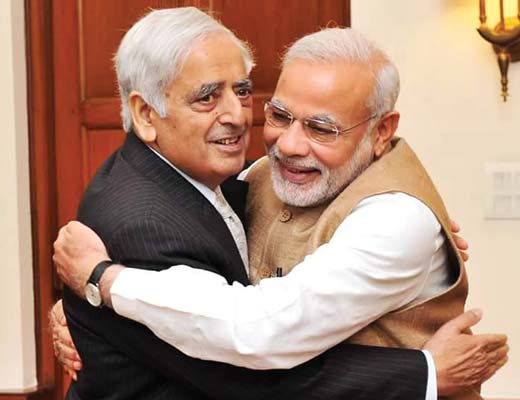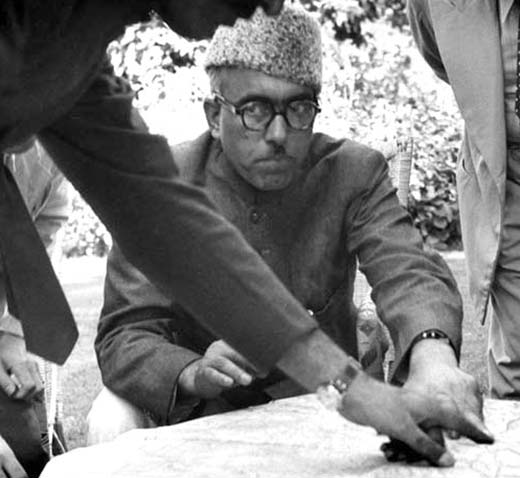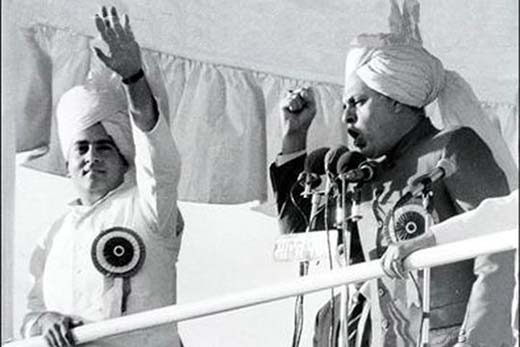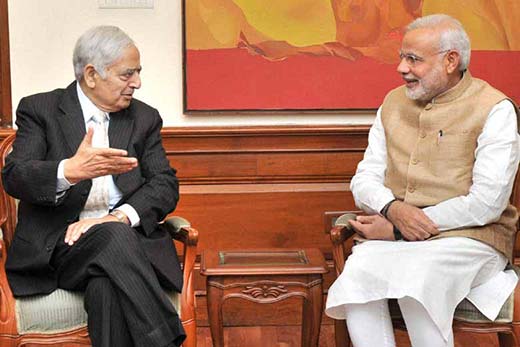Kashmir history is replete with treaties and accords. Certain agreements between Delhi and Srinagar involve the people of Kashmir directly, unlike all others. In the backdrop of famous ‘North Pole, South Pole’ hug between Narendra Modi and Mufti Sayeed – the fifth in last 430 years, Kashmir Life offers a glimpse of costs and consequences

As Gulab Singh helped a crisis-ridden Lahore durbar to capture Jammu’s popular dissident early nineteenth century, Lahore graciously imposed the Raja Gulab Singh on the temple city. Later the peak of ‘great games’ led English to sell Kashmir to the Dogra Raja for Rs 75 lakhs, a cost he never paid after taking over in 1846 amid some resistance in Srinagar.
Almost a century later, when Hari Singh, the last of the four rulers fled Kashmir in a cavalcade with the fleece of the family’s despotic and over-exploitive misrule, he acceded to India in 1947. Accession was ratified by the popular regime that replaced Hari Singh.
Kashmir has remained the subject matter of various agreements but in quite a few of them have the rulers of Kashmir, enjoying sizable influence over people, been involved directly. They have remained distinct to the situations of that time and have had their consequences as well.
Circa 1585: Sovereign Imprisoned
This was history’s first major watershed event that led Delhi to land in Kashmir. Chaks were fighting within and there were societal tensions, sometimes taking a sectarian route. Yusuf Shah, the ‘king’ made famous by his singer-poetess queen Habba Kahtoon was inefficient and lost his throne. He went to Akbar seeking (left Kashmir on January 2, 1580) help and returned in August with a direction to Mughal offices in Punjab to help him regain his status.
Frightened by an impending Mughal onslaught, nobles agreed to restore his position as long as it did not mean war. He came alone but his loyalists led to mini-wars in north Kashmir and Yousuf Shah became the king again in November 1580. He was under the impression that he did everything on his own and is sovereign but Delhi believed he was their vassal. He was summoned by Delhi and he sent his son Haider. He was summoned again and sent another son Yaqub in 1584, who fled and reached Kashmir back within a year. A final third warning failed and Akbar sent Raja Baghwan Das to take over Kashmir. Fearing a rout, Das opened negotiations and an agreement was reached in 1585.
Under the agreement, Mughals had to demilitarize Kashmir but coins were to be struck and Khutba recited in the name of Emperor Akbar. Chak king was assured of the throne once he presented himself before the Emperor and ratified the agreement.
Keeping Kashmir with his son, Yousuf presented himself before Akbar at Fatehpur Sikri on April 7, 1586. But Akbar refused ratifying the treaty and denied him permission to return. A year-long imprisonment later, he was settled in Bihar as Mansabdar of 500 horsemen. He died in September 1592 and was buried at Biswak (Patna). Das was pained that his commitment made on behalf durbar was not kept and committed suicide later. By then Kashmir was annexed to Mughal Empire on October 14, 1586 and Yaqub surrendered, after two years of rebellion, before Akbar on August 8, 1589.
Circa 1953: A Leader Deposed
In wake of partition of India, Kashmir’s Dogra despot Hari Singh was the last to decide. He wanted to keep the fief but after his actions in Poonch led to a rebellion and gradual fall of his authority that manifested by tribal raids, later supported by Pakistan formally, he acceded with India. The then mass leader of Kashmir Sheikh Mohammad Abdullah was supportive of the deal and was part of the negotiations that led to the inclusion of Article 370 in Constitution of India.
With Hari Singh in Mumbai, and the war over early 1948, the process of formalizing the state structure started. On basis of the instrument of accession, an agreement was negotiated and signed on July 14, 1952. A year after the agreement, Sheikh was deposed as Prime Minister of J&K and jailed on August 8, 1953. In the subsequent years, most of these exclusivities were neutralized.
Circa 1975: A Movement Neutralized
After spending almost 22 years in political wilderness, Sheikh Abdullah finally agreed to reconcile and get back to power. It was a series of negotiations that led to the signing of Indira-Abdullah accord on November 13, 1974, following which Sheikh took over the leadership of a Congress house on February 24, 1975.
Mrs Gandhi ensured the clocks are not turned back. While Article 370 was termed to be the main guide in dictating the centre-state relations but took over the security-related legislation for Parliament. While the accord agreed to decide on merit the adaptations and modification of various constitutional provisions implemented in the state, it asserted the provisions remain unalterable.
The accord agreed to review the laws extended to the state after 1953, especially in the Concurrent list. Sheikh, in fact, constituted a three member committee comprising of his confidants D D Thakur, Ghulam Nabi Kochak and son-in-law Ghulam Mohammed Shah in 1977 to suggest the measures for restoration of eroded autonomy after reviewing the post-1952 era. In May 1978, two reports were submitted to him. While Kochak – Shah report suggested the withdrawal of all the central laws extended to the state after Delhi agreement; Thakur proposed status quo with the contention that the extension of these laws has resulted in positive changes. The reports being highly contradictory, there was no follow up as “Sheikh Sahib was not interested in confronting centre”.
This accord is considered to be a major shift in the thought process that changed the course of NC forever.
Circa 1986: No Record Of An Accord
Reportedly “signed” on November 6, 1986 between Rajiv Gandhi and Dr Farooq Abdullah, there is no draft of it available. This accord was response to a lot of bickering after Dr Abdullah assumed power with a massive mandate after the death of his father Sheikh Abdullah. Mrs Gandhi disliked Dr Farooq for allying with anti-Congress forces and was keen to dislodge him.
Mufti Sayeed, Mrs Gandhi’s main man in Kashmir, was given the task. He exploited Ghulam Mohammad Shah’s grouse for being denied the rightful place in the political inheritance of Sheikh. A bunch of 16 lawmakers defected and voted against Dr Farooq and installed Shah.
But the situation changed after Mrs Gandhi’s assassination on October 31, 1984. Rajiv wanted his own space, friends and priorities. The two reached an understanding that mostly was defended by the two sides for helping Kashmir get better share of resources for development. It lacked any political content.
The accord led to the installation of a coalition government on November 7, 1986. A year later, the two parties decided to contest the polls together against the Muslim United Front. Polls were massively rigged and the winning candidates were sent to the jails. A year later Kalashnikovs arrived on the scene and are still around. Mufti Sayeed resigned from Congress in protest against the accord saying joining of the two parties left room for the separatist parties.
Circa 2015: Modi Mufti Bhai Bhai
This one was supposed to be a common minimum programme on basis of which ideologically opposed PDP and BJP would form the government. The two parties were thrown up as two majors with 28 and 25 seats in an 87-member house. But the accord, that is now being termed as agenda for alliance with a projection of being key indicator of the beginning of a reconciliatory process.
Though the copy of the accord is being made public after the Mufti led BJP-PDP alliance takes over on Sunday – March 1, 2015, the leaks suggested that it has a strong political content, although brief. Most of the document is dictated by the prevailing situation in J&K that was the outcome of the 1986 ‘accord’. It has more focus on development and investment and almost everything is linked to politics.
The accord was negotiated for nearly two months by PDP ideologue Dr Haseeb Drabu and BJPs general secretary Ram Madhav.
The major political part of the document is termed to BJP acceptance that it would respect and uphold the special constitutional guarantees that J&K enjoys. It has remained the key component of the right wing parties since 1947 and vital in marking the beginning of erosion of autonomy in early sixties.
Situational dictations on the document include an understanding that the new regime will take care of the AFSPA, evict illegal occupation of spaces by armed forces, and ensure engaging separatists for dialogue. It also makes it abundantly clear that Delhi will talk to Pakistan, as peaceful neighbourly relation with Islamabad is key to keeping Kashmir peaceful. This was resisted initially by BJP saying foreign affair is a central subject but eventually it relented.
Apart from liberal investment and rebuilding Kashmir, destroyed by floods, the two parties have agreed to work out a system to get back two of the four power projects that NHPC owns and runs in the state.
But what will be the consequences of the deal will be known once the romance of the documents is over and the implementation starts. BJP is going to polls in many states and PDP will have to hard-sell its package in Kashmir that has opposed the deal tooth and nail.




















